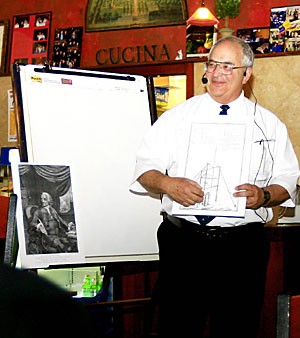In 1752, Benjamin Franklin decided to fly a kite. With a sharp metal rod on the end … linked by cotton thread to a metal key. And in a thunderstorm. It is safe to say this was a possibly lethal experiment.
Despite that, it is still considered “”the most important experiment in the physical sciences in the 18th century,”” said E. Philip Krider, an atmospheric sciences professor, at the Flandrau Science Center’s latest “”got Science? Café”” event. The event was held yesterday evening at Enoteca Pizzeria Wine Bar, 58 W. Congress St.
Amid free appetizers at the restaurant, open specially for the event, Krider gave a brief talk about Benjamin Franklin and electricity, and answered questions ranging from Franklin’s political status to complex science questions about lightning.
His experiments were “”ultimately the thing that led to Franklin’s fame,”” Krider said, adding that the revelation that electricity existed in nature, as part of the weather, was especially important in changing the way people thought at the time.
Despite “”almost killing himself”” with his experiments – including one involving the electrocution of turkeys – Franklin’s fame helped make him vitally important in garnering French aid during the American Revolution, Krider said.
The audience showed a keen interest in the more scientific and technical aspects of lightning, asking about its uses for power (not economical due to its short span, Krider said) and inquiring about ball lightning and other phenomena.
Krider’s research, which he discussed at some length, included trying to determine how clouds generate electricity, as well as work on lightning prediction and prevention that is a part of the National Lightning Detection Network.
He gave several tips that may help should anyone be struck by lightning, such as that wet clothes offer more protection than dry and that there may be evidence that metal in clothing can help limit damage.
Although several students attended the event, the audience was mostly drawn from the community beyond the university.
Stacy Fleenor, an atmospheric sciences graduate student, said she wanted to see what the café was like.
“”It’s a nice little place,”” she said.
Shipherd Reed, project coordinator for the Miner’s Story Project, moderated the event. He is also running the café this year.
“”We put the word out and invite people to speak,”” Reed said of arranging for speakers. “”It’s rewarding for the scientists and for fans of science.””
With Flandrau poised to move downtown, Reed said making connections with the community is a vital project.
“”There’s a lot of interest in the event from people not connected to UA,”” Reed said. “”We usually get about 40 people.””
“”I’m surprised so many people were interested,”” Krider said. “”I enjoyed the opportunity to speak.””
“”Got Science?”” began April 2006 and is held once a month.
The next meeting, “”Why are there mountains?”” featuring Peter L. Kresan, a retired senior lecturer in geosciences, will be held Jan. 7.









